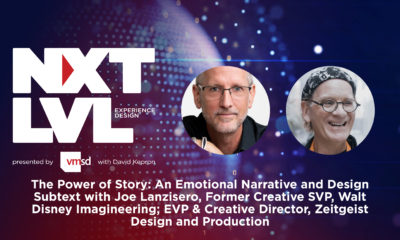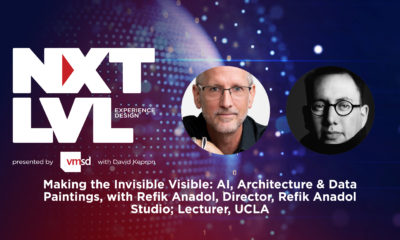Across the episodes of the “Be Creative. Be Brave.” series, I have moved from the rise in technology in the 1800s and the story of the Luddites in the early days of the Industrial Revolution to present day and the way that technology is intricately woven into the matrix of our everyday lives. The pervasiveness of technology and its influence on almost every aspect of our lives is undeniable. It has brought extraordinary positive human progress in facilitating the things we do in our everyday lives to our exploration of the cosmos. Some of these advancements have also created cause for concern about the little blue dot we all live on.
Increasingly, in what seems to be a countervailing force against technology’s influence on our lives, we are seeing a massive growth in mindfulness and meditation practices; yoga; Ayurveda; mind-altering, shaman-led ayahuasca rituals; forest bathing and growth in a wellness economy that, according to the Global Wellness Institute, is valued at $4.5 trillion. Being well in both mind and body requires a conscientious practice of balancing the speed of our digitally enabled lives with returning to rituals deeply rooted in our DNA.
The concept of biophilia is influencing the design of places, integrating nature into the built environment with the recognition that when we are connected to nature, we simply feel better. Green feature walls, air-cleaning plants and simple visual cues that reference natural materials and settings support well-being and make people feel more at peace, healthier and more connected.
Amazon Spheres are a prime example of the power of biophilic design. The air smells and feels different. The oxygen is thicker, and the humidity soothes the throat and lungs when breathing deeply. Of course, not every building can be the Amazon Spheres, and maybe the complex of enormous plastic bubbles is just a test run for Jeff Bezos’ dream for living on Mars. Interestingly though, when you walk into the public space off of the street in Seattle, the environment presents striking digital imagery of verdant places, plants and flowers. You might think that if it is biophilic it must be real to be effective but compelling digital representations of natural places have the same effect on the brain as the real thing. By the way, fake plants, not so much. This, too, invites us to consider the use of digital imagery projected into places if you can’t have the real thing.
For example, the Mori Building Digital Art Museum in Tokyo features an interactive digital forest-bathing experience. In this environment, visitors can walk through waist-high “gardens” that react to touch by changing color in real-time. Guests can stroll though large exhibition spaces where floors and walls are bathed in beautiful digital imagery, including water that seems to flow over rocky outcrops.
But then again, not every place can be a veritable biodome, whether in fact or in digital fractals. When space and budgets get smaller, you cinch in the experience-place belt and move down to single human-sized environments. Taking us further into the single-user digital realm, Sensiks has introduced immersive sensory reality pods, which feature light, color, VR visuals, sound and other atmospheric qualities, providing a restorative step aside from the fast-paced flow of everyday contemporary life. The user is immersed in “… audio-visual experiences [that] are synchronized with scent, temperature, air flow, tremble, taste and light frequencies. By stimulating all senses simultaneously and connecting them to a harmonious integral experience, your brain will be activated on multiple points. It makes you feel that you really are in the experience.”
Advertisement
That “as if” feeling is a unique characteristic of our human brain. It is remarkable that when we read, hear or watch stories, our brain has the ability to insert us into the context of the narrative. We can see, in our mind’s eye, the characters, landscapes, colors, the big picture and the tiny details. If it can be described, we can see it in our head and feel the emotion of the story.
With this understanding of the power of narrative to light up the brain, we begin to see why story (even if digitally mediated through a screen) is powerful, not just for the sharing of information, but for the sharing of emotions. Stories activate neurobiochemical reactions that directly affect our affect. If you hear a story often enough, even the ones we tell our selves, they are hardwired into our brains. Know your story, and you’ll know yourself. Change your internal narrative, and you’ll change yourself.
When designers of brand experiences consider the potential impact of sensory-based but digitally mediated experiences, they can also rely on one of the largest sense organs we have: Our skin. Haptics, using our sense of touch, has been used for some years; your phone vibrating while on silent mode for example. It is now believed that “incorporating an element of touch drives a 62 percent increase in feelings of connection with an advertised brand, and leads to a 50 percent lift in brand favorability (Immersion, 2018).”
A particularly powerful example of haptic technology was launched by Ford in May 2018. “Feel The View” is a vibrating smart window that takes pictures of the landscape out side the window, and translates them into various vibrating pixels whose frequency changes with the shape and lightness or darkness of the image. As a visually impaired passengers runs their hand across the glass window they literally feel a picture of what is beyond the glass. “We seek to make people’s lives better and this was a fantastic opportunity to help blind passengers experience a great aspect of driving,” said Ford spokesman Marco Alù Saffi. “The technology is advanced, but the concept is simple – and could turn mundane journeys into truly memorable ones.” This use of technology that allows the blind to “see” is remarkable. “Feel The View” is touching both literally and emotionally, and digital technology at one of its finest moments.
For many years, brands have focused their efforts on connecting to customers through mobile and social platforms. As we begin to discover the power of technology to deliver sensory-based experiences, I believe we will see a rise in companies looking towards connecting with more signature moments that rely on digitally-mediated multi-sensory stimulation that engage both guests emotionally and physically.
Digital technology will support an already deeply ingrained need for us to create stories. Immersive experiences will only continue to be more common. The designers, place-makers and brands who embrace technologies as a vehicle to engage customers have their work cut out for them when competing for attention with fantastical digital worlds where the laws of physics don’t apply. Creators of places will need to be willing to go through the hard work of transforming. Profound change will be a survival strategy, despite fears of being overshadowed or made obsolete by technology. Adopting a growth mindset, where change is seen as an opportunity for growth rather than something to be feared, will be necessary because new tools are reshaping the experience environments we are so used to creating.
Advertisement
The weavers who became known as the Luddites were deeply knowledgeable about their craft. What if they had fully embraced the new machines rather than trying to destroy them?

 Photo Gallery1 week ago
Photo Gallery1 week ago
 Headlines1 week ago
Headlines1 week ago
 Headlines2 days ago
Headlines2 days ago
 Headlines1 week ago
Headlines1 week ago
 Headlines1 week ago
Headlines1 week ago
 Designer Dozen2 weeks ago
Designer Dozen2 weeks ago
 Designer Dozen6 days ago
Designer Dozen6 days ago
 Headlines1 week ago
Headlines1 week ago





















